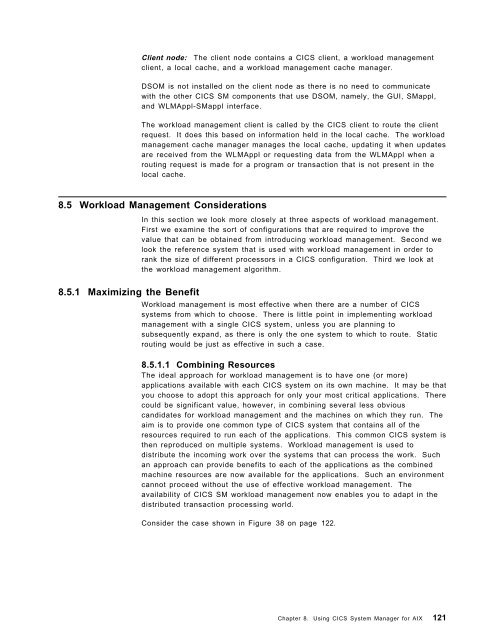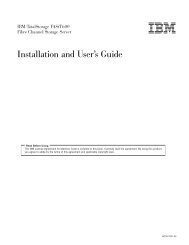Addressing OLTP Solutions with CICS: The Transaction Server ... - Ibm
Addressing OLTP Solutions with CICS: The Transaction Server ... - Ibm
Addressing OLTP Solutions with CICS: The Transaction Server ... - Ibm
You also want an ePaper? Increase the reach of your titles
YUMPU automatically turns print PDFs into web optimized ePapers that Google loves.
Client node: <strong>The</strong> client node contains a <strong>CICS</strong> client, a workload management<br />
client, a local cache, and a workload management cache manager.<br />
DSOM is not installed on the client node as there is no need to communicate<br />
<strong>with</strong> the other <strong>CICS</strong> SM components that use DSOM, namely, the GUI, SMappl,<br />
and WLMAppl-SMappl interface.<br />
<strong>The</strong> workload management client is called by the <strong>CICS</strong> client to route the client<br />
request. It does this based on information held in the local cache. <strong>The</strong> workload<br />
management cache manager manages the local cache, updating it when updates<br />
are received from the WLMAppl or requesting data from the WLMAppl when a<br />
routing request is made for a program or transaction that is not present in the<br />
local cache.<br />
8.5 Workload Management Considerations<br />
8.5.1 Maximizing the Benefit<br />
In this section we look more closely at three aspects of workload management.<br />
First we examine the sort of configurations that are required to improve the<br />
value that can be obtained from introducing workload management. Second we<br />
look the reference system that is used <strong>with</strong> workload management in order to<br />
rank the size of different processors in a <strong>CICS</strong> configuration. Third we look at<br />
the workload management algorithm.<br />
Workload management is most effective when there are a number of <strong>CICS</strong><br />
systems from which to choose. <strong>The</strong>re is little point in implementing workload<br />
management <strong>with</strong> a single <strong>CICS</strong> system, unless you are planning to<br />
subsequently expand, as there is only the one system to which to route. Static<br />
routing would be just as effective in such a case.<br />
8.5.1.1 Combining Resources<br />
<strong>The</strong> ideal approach for workload management is to have one (or more)<br />
applications available <strong>with</strong> each <strong>CICS</strong> system on its own machine. It may be that<br />
you choose to adopt this approach for only your most critical applications. <strong>The</strong>re<br />
could be significant value, however, in combining several less obvious<br />
candidates for workload management and the machines on which they run. <strong>The</strong><br />
aim is to provide one common type of <strong>CICS</strong> system that contains all of the<br />
resources required to run each of the applications. This common <strong>CICS</strong> system is<br />
then reproduced on multiple systems. Workload management is used to<br />
distribute the incoming work over the systems that can process the work. Such<br />
an approach can provide benefits to each of the applications as the combined<br />
machine resources are now available for the applications. Such an environment<br />
cannot proceed <strong>with</strong>out the use of effective workload management. <strong>The</strong><br />
availability of <strong>CICS</strong> SM workload management now enables you to adapt in the<br />
distributed transaction processing world.<br />
Consider the case shown in Figure 38 on page 122.<br />
Chapter 8. Using <strong>CICS</strong> System Manager for AIX 121
















